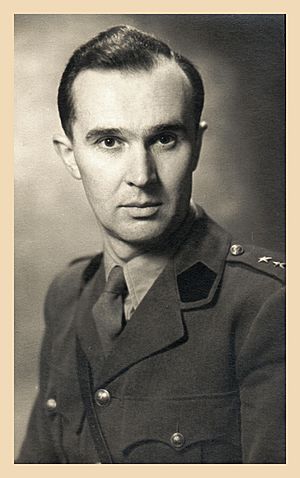Wacław Struszyński facts for kids
Wacław Struszyński (1904–1980) was a Polish electronics engineer. He played a very important role in helping the Allies win the Battle of the Atlantic during World War II. He invented a special radio antenna. This antenna helped ships find German submarines, called U-boats.
The system was called HF/DF or Huff-Duff. It helped ships figure out where U-boats were by listening to their radio signals. This was a huge help in protecting supply ships.
Contents
Early Life and Education
Wacław Struszyński was born in Wieruszów, Poland, in 1904. He spent his early years in Moscow. In 1918, his family moved back to Poland.
He studied engineering at the Warsaw University of Technology. He earned his master's degree in 1929. After that, he worked for the Polish State Telecommunication Establishment. He became the head of their Direction Finding Division. When Germany invaded Poland in 1939, he had to leave Warsaw. He arrived in England in 1940.
Wacław's father, Professor Marceli Struszynski, was a chemist. During World War II, his father worked with the Polish resistance. He helped analyze the fuel used in the German V2 rocket.
World War II Contributions
Tracking U-boats with Radio
During World War II, German U-boats often worked together in groups called "wolf packs." They used high-frequency radio signals to talk to each other. These signals could travel long distances. British codebreakers at Bletchley Park could often decode these German messages. This information, called Ultra intelligence, helped Allied ships avoid U-boat attacks. However, ships still needed a way to find U-boats nearby.
It was very important for Allied escort ships to know where U-boats were. They needed to find the direction of the U-boats' radio signals. This was much harder to do on a ship than on land. The metal parts of a ship could bounce radio signals around. This made it very difficult to get an accurate reading. The biggest challenge was designing a radio antenna that could work well at sea.
Struszyński's Amazing Antenna
When Struszyński arrived in England, he joined the HM Signal School. This was a special research center for naval signals. Very quickly, he found a way to solve the problem of radio signals bouncing off ships. He also added a special feature to the antenna. This feature helped tell the difference between a real signal and a reflected one.
He led a team that built a working antenna. This antenna allowed effective high-frequency direction finding systems to be put on Royal Navy escort ships. His invention was a major step forward in naval warfare.
Why Struszyński's Work Was So Important
The Germans thought it was impossible to track U-boats well from ships. Because of this, U-boats kept using their high-frequency radios. This allowed Allied escort ships to find them. Once an escort ship knew where a U-boat was, it could go after it. This often forced the U-boat to retreat or even led to its destruction. Allied aircraft could also be told where the U-boats were.
The American naval historian Clay Blair Jr. called Struszyński's antenna design "a breakthrough of transcendent importance." He said that people often gave more credit to radar and codebreaking. But he believed that Huff-Duff was just as important, even if it was less famous.
Ralph Erskine, an expert on the Enigma machine, agreed. He said that without shipborne high-frequency direction finding, Allied convoy losses in early 1943 would have been much higher. He estimated losses would have been 25 to 50 percent greater. Also, fewer U-boats would have been destroyed. This period was when the Allies really started to defeat the U-boats in the North Atlantic.
German naval historian Jürgen Rohwer also studied the war. He looked at British and German records. He concluded that the outcome of major convoy battles always depended on how well high-frequency direction finding was used.
Rohwer also noted that the Germans did not know about the shipborne HF/DF. They thought their U-boat failures were due to Allied radar. Both radar and HF/DF were vital tools. But HF/DF could find a U-boat much farther away than shipborne radar could.
After the War
After the war, Struszyński worked at the Marconi Research Laboratories in England. He was a consultant in communications research. He continued to work there until he retired.
See also
- Anti-submarine warfare
- List of World War II British naval radar
- List of World War II electronic warfare equipment
- Radar in World War II
- Radio direction finder
- Signals intelligence


